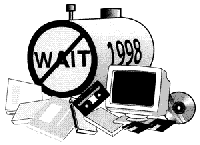
Leaking Underground Storage Tanks
Developed by Joe Ryan, University of Colorado
Contaminants
Federal
UST Legislation
State Support
Cleanup Status
UST Definitions
Colorado
Oil Inspect Sec
UST Data
LUST
Anatomy
Corrosion
Leaks
Site Character
Remediation
Source
Groundwater
New Tanks
Installation
Monitoring
 Federal LUST Regulations (continued)
Federal LUST Regulations (continued)
Cleanup Status. EPA estimates that since the federal underground storage tank (UST) program began, nearly 1.2 million of the roughly 2.1 million petroleum tanks subject to regulation have been removed from service, leaving approximately 919,000 active USTs. As of June 1998, more than 358,000 releases had been identified, nearly 302,000 cleanups had been initiated, and 192,000 cleanups had been completed. EPA expects that many more LUSTs will be identified as owners and operators act to comply with leak prevention and detection regulations that took effect in December 1998. Discovery of more releases seems likely, given that EPA estimated in October 1998 that roughly 40% of 919,000 active tanks had yet to be upgraded, replaced, or closed.
In about 95% of cases, EPA or states have been successful in getting responsible parties to perform the cleanup. In these cases, the cleanup costs have been typically paid for by the responsible party, a state fund, and private insurance. As mentioned, states and EPA use LUST Trust Fund money primarily to oversee cleanups by responsible parties and to take enforcement actions at leaking UST sites. In those cases where Fund monies are used directly for cleanup, the law requires responsible parties to be held liable in cost recovery actions for such expenditures.
Definitions and Details. The EPA regulations define an underground storage tank (UST) as a tank and any underground piping connected to the tank that has at least 10 percent of the combined volume of the tank underground. EPA regulations apply only to underground tanks and piping storing either petroleum or certain hazardous substances. Some USTs are exempted from EPA regulations and do not need to meet Federal requirements for USTs. Some of these these types of USTs may, however, be covered by state regulations:
-
Farm and residential tanks of 1,100 gallons or less capacity holding motor fuel used for noncommercial purposes
-
Tanks storing heating oil used on the premises where it is stored
-
Tanks on or above the floor of underground areas, such as basements or tunnels
-
Septic tanks and systems for collecting storm water and wastewater
-
Flow-through process tanks
-
Tanks of 110 gallons or less capacity
-
Emergency spill and overfill tanks
Owners of existing USTs (tanks installed before December 22, 1988) were required to upgrade, replace, or close their USTs by December 22, 1998. Upgrading requirements include
-
Corrosion protection for tanks and piping -- tank and piping must be constructed of noncorrodible material or material with cathodic protection (for structurally sound tanks).
-
Spill protection -- catchment basins, proper tank filling practices.
-
Overfill protection -- automatic shutoff devices, overfill alarms, or ball float valves.
The codes also set minimum standards for new tanks. Standards for new tanks include
-
Secondary containment and interstitial monitoring -- a vault or liner and dipstick or automated vapor or liquid sensors.
-
Automatic tank gauging systems -- monitors of product level and temperature
-
Vapor monitoring -- monitoring wells for detecting product vapor in the soil around the tank and piping.
-
Groundwater monitoring -- monitoring wells for detecting liquid product floating on the groundwater table.
-
Statistical inventory control -- statistical analysis of inventory, delivery, and dispensing data.
-
Manual tank gauging -- dipstick monitoring of tank contents, only for tanks 2,000 gallons or smaller.
-
Tank tightness testing -- pressure testing.
In general, these provisions are considered a major step forward in preventing groundwater pollution. Still, the manual tank gauging guideline was not considered acceptable by some organizations reviewing the regulations (e.g., the Environmental Defense Fund).

The EPA's Underground Storage Tank web
site

The EPA provides a comprehensive catalog of its materials
on USTs -- publications, videos, and a guide to internet availability
of these materials.